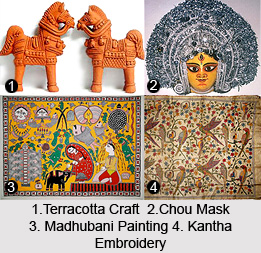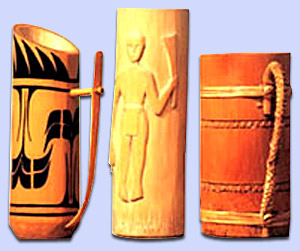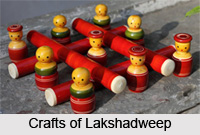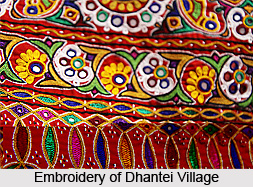 Handicrafts have always held an integral position in the lives of Indians. In East India also crafts work has maintained its rich legacy and culture. The East Indian Crafts speak of dexterity and sense of artistry of the locals. The East Indian states of India comprise of Bihar, West Bengal, Odisha and Jharkhand.
Handicrafts have always held an integral position in the lives of Indians. In East India also crafts work has maintained its rich legacy and culture. The East Indian Crafts speak of dexterity and sense of artistry of the locals. The East Indian states of India comprise of Bihar, West Bengal, Odisha and Jharkhand.
Toy making
Toy making is a craft in the region. In Toupadana of Jharkhand state, "wooden toys" are made which are completely abstract. The toys are always in pairs, which are stunning and very original as they are different from other dolls. In Krishnagar of West Bengal state, "traditional dolls" are made from clay, which have been widely acclaimed and are displayed in museums all over the world.
Textile Craft
West Bengal is also famous for kantha embroidery and weaving cotton sarees in handlooms, which are called "tant sarees". Another variety of silk sari, which is produced in West Bengal, is the Baluchari sarees. The Baluchari sarees mainly come in dark shades like red, purple and chocolate. The royalty patronized this craft in the past.
Mask Making
An essential part of East Indian crafts is "mask making". The masks of Jharkhand are very different from those of Bihar as they are fiercer because the facial expression is overstated. In Purulia district of West Bengal, chou masks are made of papier - mache which has an earthy element in it.
In Odisha, painted masks are created out of wood, sholapith and other available raw materials. The masks are painted in soothing colours. The papier - mache masks of Bihar have acquired a modern dimension over the years. Originally the masks were made of wood, bamboo and pumpkin shells.
Paintings
Bihar is also well known for its Madhubani paintings which have been a part of the state since the time of Ramayana. In the earlier days, the paintings were created on mud plastered walls. Now they are drawn on handmade paper, canvas and different types of clothes. The themes of Madhubani paintings revolve around images of deities, birds, animals etc.
Metal craft
Odisha is the hub of pure silver filigree work. Cuttack is famous for this craft which is centuries old and is often called Chandi Tarakasi. It is believed to have been introduced by the Mughals. The process is highly elaborate, using precision, patience and skilled handwork, apart from the ingenuity and creativity of the artisans.
Clay craft
West Bengal is famous for terracotta craft where the terracotta horses are exquisite piece of artistry. The finest patterns of terracotta panels can be found in Bengal towns of Murshidabad, Birbhaum, Bishnupur, Hooghly and Digha. The theme is generally folk and the patterns are fairly highlighted with traditional skill and explicit artwork.
Wood craft
Jharkhand, which has dense forests, have mastered the craft of woodwork, which includes attractive articles like door panels, boxes, windows, wooden spoons etc. In Bihar, carpets, lacquer ware and wood inlay are popular.






